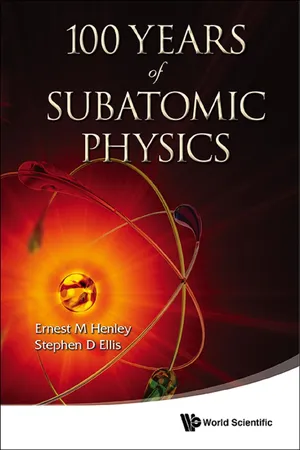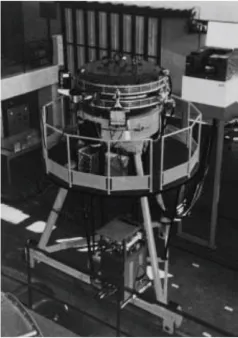![]() Part II: Particles Physics
Part II: Particles Physics![]()
Chapter 10
A Short History of Colliders
LYNDON EVANS
CERN, Meyrin, 1211 Genewa 23, Switzerland
Imperial College London, SW7 2AZ, UK
1. Introduction
Until the late 1960s, the high-energy frontier of nuclear and particle physics was dominated by the great proton synchrotrons. The Cosmatron at Brookhaven and the Bevatron at LBL were soon followed by the AGS and the CERN Proton Synchrotron. In these machines protons were directed to internal or external targets in which secondary particles were produced.
The kinematical inefficiency of this process (centre-of-mass energy only increasing as the square root of the beam energy) was recognised very early. In 1943 the Norwegian engineer Rolf Wideroe patented the idea of colliding beams, keeping the centre-of-mass at rest in order to exploit the full energy for the production of new particles. One of the main problems was to get colliding beam intensities high enough for a useful event rate to be achieved. In the 1950s the prolific group at the University of Winsconsin Midwestern Universities Research Association (MURA) led by Donald Kerst worked on the problem of stacking particles to increase the beam intensity. They mainly concentrated on protons, where Liouville's theorem, which states that for a continuous fluid under the action of conservative forces the density of phase space cannot be increased, was thought to apply. Only later, ways to beat Liouville were found to overcome this limitation. In 1956 International Accelerator Conference at CERN, Kerst made the first proposal to use stacking to produce colliding beams (not yet storage rings) of sufficient intensity. Although nothing came of this proposal, the technique of stacking protons was used in the world's first proton-proton collider, the Intersecting Storage Rings (ISR) at CERN.
Although MURA was the most active center, it was not the only place where colliding beams were being investigated. At that same conference, Gerry O'Neill from Princeton presented a paper proposing that colliding beams could be achieved in storage rings, independent of the accelerators that produced the beams. He also recognised that electrons could be used instead of protons and that this could have considerable advantages. When bent on a circular orbit, electrons emit synchrotron radiation, which is a non-conservative process and therefore not confined by Liouville's theorem. Synchrotron radiation produced a damping of the transverse oscillations of the electrons, allowing them to be concentrated into a dense beam and also to be stacked into the same volume of phase space. Synchotron radiation damping also helps to control beam instabilities and the inevitable imperfections in the guide field that would drive particles to large amplitude.
2. The Pathfinders
At that point the action moved to Stanford where the Mark III linear accelerator was the ideal source of particles to test these ideas. A report outlining the design of the 500 MeV Princeton-Stanford colliding beam experiment was published in 1958 and construction started in that same year. At the same time, the Budker Institute for Nuclear Research (BNIP) in Novosibirsk started work on VEP-1, a pair of rings designed to collide electrons at 140 MeV.
On March 7, 1960, Bruno Touschek gave a seminar at the Laboratori Nazionali di Frascati in Italy where he first proposed a single ring electron-positron collider, a 250 MeV ring with a radius of only 0.6 m. This machine was baptized AdA, the Italian acronym for Anello di Accumulazione which produced the first stored electron and positron beams on February 27, 1961, less than a year after Touschek's seminar, a far cry from the time it takes today's machines from conception to operation. AdA was moved in 1963 to Orsay in France where the Orsay linac was a much more powerful injector. This pioneering machine proved the feasibility of electron-positron colliders and elucidated a number of problems encountered
Fig. 1. AdA, the first electron-positron collider (Courtesy FRASCATI).
when operating such machines, not the least of which was the "Touschek effect", Coulomb scattering between particles in the same bunch, a modified form of which is responsible for one of the performance limitations in the Large Hadron Collider.
These three first-generation machines did not use the Alternating Gradient focussing principle, known today as strong focussing, put forward by Courant, Livingston and Snyder in 1952 (and invented two years earlier by Christofilos but not published). Further generations of colliders would all use this principle, which greatly enhances performance and reduces the cost.
Before leaving this first generation of storage rings, it is worth mentioning one machine, a little out of the mainstream of collider development, the Cambridge Electron Accelerator (CEA), that made an important advance and also spawned a generation of very talented accelerator builders who were to make their own contributions later. The CEA machine was a 2.5 GeV electron synchrotron that was converted in 1973 into a colliding beam storage ring by adding a "bypass". It was a machine, in the words of John Rees "of staggering complexity". Nevertheless, it was made to work, and under the guidance of Ken Robinson and Gus Vos, a new feature was added which was to be the key to enhancing the luminosity of all future machines. This was the "low-beta insertion" where the lattice functions are locally strongly perturbed to produce a very small beam size at the collision point.
3. The "Production" Electron–Positron Machines
From about 1969, the construction of colliding beam storage rings for physics, where the detectors were an integral part of the machine design took off in earnest. Figure 2 shows the evolution of centre-of-mass energy of colliders as a function of the first year of operation. There are two lines, one for leptons (mainly electron-positron) and the other for hadrons (more to come later). The first of these big machines was ADONE, built at Frascati in 1963-69 and incorporating everything that was learned from the first generation. It had a radius of 16.5 m using the strong focussing principle and with a low-beta insertion. The design energy of ADONE was 1.5 GeV or 3 GeV in the centre-of-mass, unfortunately chosen to be just below the production threshold of 3.1 GeV for the J/Psi which was to be discovered by its cousin SPEAR built on a car park at Stanford Linear Accelerator center. SPEAR was a 3.7 GeV electron-positron storage ring, built in 1973 and incorporated the first modern four-pi detector (Mark I) which was to be the prototype of all future detectors. In the fall of 1974, SPEAR was responsible for the "November Revolution" with the discovery of the J/Psi. In fact, once the J/Psi was discovered, ADONE was pushed up in energy by only 100 MeV and in a few days the existence of the resonance was confirm...

